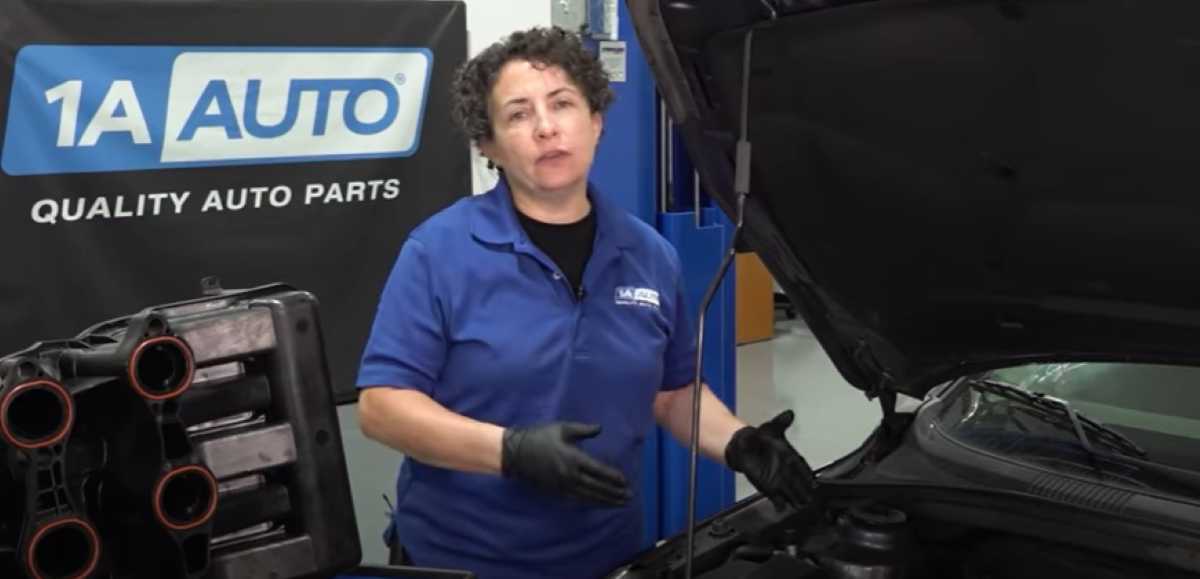In this article and video, we show how a vacuum leak in a car can cause problems with fuel mileage. Your engine might be dumping and using way more fuel, like a flowing river, when all you need is a small amount, like some water poured from a small cup. You’ll find out what can cause a vacuum leak in a car, symptoms of a vacuum leak, and how to diagnose them yourself.
How to Find a Repair a Vacuum Leak in Your Car
This article reviews vacuum leaks in general and how to fix them in your car yourself.

Symptoms of a Vacuum Leak in a Car, Truck, or SUV
Oil Leak
Oil leaks can damage gaskets. If the gasket is a rubber seal like on the intake manifold, petroleum in the oil can expand the rubber. If the gasket is made of paper, oil can deteriorate it.
More on how to find an oil leak in your car
Intermittent Check Engine Light
Non life-threatening codes like EVAP codes or a code related to an oxygen (O2) sensor can cause an intermittent check engine light, but a vacuum leak can too. Intake manifold especially can turn on a check engine light. A cool engine and the outside temperature can have a tighter fitment that loosens as the car warms up, and the opened vacuum leak can turn on the check engine light after the engine has been running.
Check Engine Light for an O2 Sensor Code
You’ll likely get a check engine light for an O2 sensor code, like the engine running rich. If this happens, the O2 sensor is actually doing its job and you don’t need to replace it. The vehicle’s computer is actually compensating for the vacuum leak by dumping more fuel.
Sound of Air Escaping
As air escapes, vacuum leaks can make a sound that’s similar to the sound heard when you open a plastic bottle slowly.
How to Find a Vacuum Leak in Your Car
Steps to find a vacuum leak in your car
- Check the Air Intake Box
Every car will have an air intake filter housing box that’s sealed. The box can be sealed in different ways, like with screws or clamps. Check the box and make sure it’s secured tightly and sealed properly.
- Check the Air Intake Filter
The engine air intake filter sits inside the air filter box. Remove the cover from the box and inspect the air intake filter. A brand new air filter will be clean with no debris. Look at the fins for dirt, and replace the air filter if you find it’s dirty.
More on how to check the engine air filter
- Check the Mass Airflow (MAF) Sensor
Most modern cars have a MAF sensor. A defective MAF sensor will trigger the check engine light for an MAF code. If the MAF sensor is causing a vacuum leak, you won’t get a MAF-code but instead a running-rich code. The seal on the MAF sensor can cause a code if air is leaking. Make sure the seal is there and is secured nice and tight and not swollen. Make sure there is also no debris like a leaf or oil on the wire taking the reading.
You may be able to clean the MAF sensor with MAF sensor cleaner and test it, but we recommend replacing the MAF sensor if you find an issue with it since the cleaned MAF sensor may not work properly.
More on how to inspect the MAF sensor
- Check the Air Intake Hose
The air intake hose connects to the throttle body and the air intake box. May sure the tube is clamped tightly.
- Check the Turbo If Your Car Has One
If your car has a turbo, follow the air line. Problems can occur where the air line connects to the throttle body. The clamps can loosen and suck air right into the air intake, causing a vacuum leak.
- Check the Lines and Gaskets for a Vacuum Leak with Soapy Water
The gaskets on air intake system parts can fail from age, wear, and tear.
To test for a vacuum leak, grab a shop vacuum and set it up for the reverse, exit air function. Then remove the air intake tube from the throttle body and connect the vacuum’s tube to it. Make sure the vacuum tube connected to the throttle body is sealed, and use duct tape if you have to. Then put soapy water into a spray bottle.
To do this test, the car does not need to be running. With everything hooked up, turn the vacuum on so air is entering the throttle body. While it blows air through, spray soapy water in the area where the intake manifold meets the engine’s cylinder head. Spray any lines and the vacuum booster. The water will bubble wherever the vacuum leak is.
We recommend looking for a vacuum leak in your car with soapy water instead of carburetor cleaner spray. With carb spray, you’ll need to have the engine running and if it lands too close to the exhaust or O2 sensor, it could damage them. And, in the case of the exhaust, it could spark a flame.
Use Our How-to Videos to Replace Parts
If you found a vacuum leak and you need to replace a part like the intake manifold, check out our how-to videos. Many air intake parts are easy to replace yourself, and you can save money with DIY repairs on your car following our step-by-step instructions.
Find more how-to videos at the 1A Auto video library


